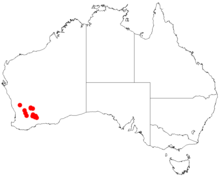| Acacia cracentis | |
|---|---|
| Scientific classification | |
| Kingdom: | Plantae |
| Clade: | Tracheophytes |
| Clade: | Angiosperms |
| Clade: | Eudicots |
| Clade: | Rosids |
| Order: | Fabales |
| Family: | Fabaceae |
| Subfamily: | Caesalpinioideae |
| Clade: | Mimosoid clade |
| Genus: | Acacia |
| Species: | A. cracentis
|
| Binomial name | |
| Acacia cracentis | |

| |
| Occurrence data from AVH | |
Acacia cracentis is a shrub belonging to the genus Acacia and the subgenus Juliflorae that is endemic to south western Australia.
Description[edit]
The bushy shrub typically grows to a height of 0.5 to 2 metres (2 to 7 ft)[1] with a rounded or obconical habit. The branchlets are sericeous between the resinous ribs particularly at the extremities. Like most species of Acacia it has phyllodes rather than true leaves. The patent to ascending, slender green phyllodes are straight to slightly incurved with a length of 2.5 to 6 cm (0.98 to 2.36 in) and a diameter of 0.5 to 0.7 mm (0.020 to 0.028 in) that have eight broad flat topped nerves that are barely raised.[2] It blooms from July to September producing yellow flowers.[1] The simple inflorescences are usually solitary with sessile flower-heads that has a spherical or near sperical shape and a diameter of 4.5 to 6 mm (0.18 to 0.24 in) containing 12 to 20 flower golden coloured flowers. The seed pods that form after flowering are erect with a linear shape but are marginally raised over and constricted between each of the seeds. The thinly coriaceous pods are straight to slightly curved with a length of up to 5 cm (2.0 in) and a width of 1 to 2 mm (0.039 to 0.079 in). The glossy mottled seeds are longitudinally arranged inside the pods. The seeds have an elliptic shape with a length of 2 to 2.5 mm (0.079 to 0.098 in) with a blunt white terminal aril.[2]
Distribution[edit]
It is native to a small area of the Wheatbelt region of Western Australia[1] where it has a scattered distribution from around the Chiddarcooping Nature Reserve in the north down to around Hyden the south over a distance of about 200 km (120 mi) where it is often situated among and around granite outcrops growing in gravelly loam soils as a part of Melaleuca shrubland or low heath communities and is also associated with Eucalyptus stowardii and species of Casuarina.[2]
See also[edit]
References[edit]
- ^ a b c "Acacia cracentis". FloraBase. Western Australian Government Department of Biodiversity, Conservation and Attractions.
- ^ a b c "Acacia cracentis". WorldWideWattle. Western Australian Herbarium. Retrieved 30 March 2020.